Quick Look: PowerColor’s Radeon HD 5770 PCS+ Vortex Edition
by Ryan Smith on August 25, 2010 11:22 AM EST- Posted in
- GPUs
- AMD
- Radeon
- PowerColor
Power, Temperature, & Noise
For our look at power, temperature, & noise, we’ve run the Vortex with the fan both retracted and extended. As we normally test cards with the fan speed on automatic we’ve gone ahead and continued this practice here, though we’ll note that the fan position had absolutely no effect on what speed the card ultimately chose to run the fan at, likely because of the nearly non-existent difference in temperature.
For our charts here, the Vortex's fan is in its lowered position unless otherwise noted.
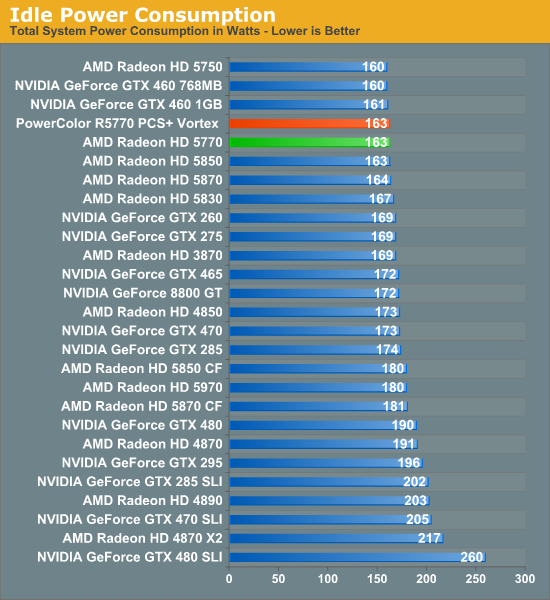
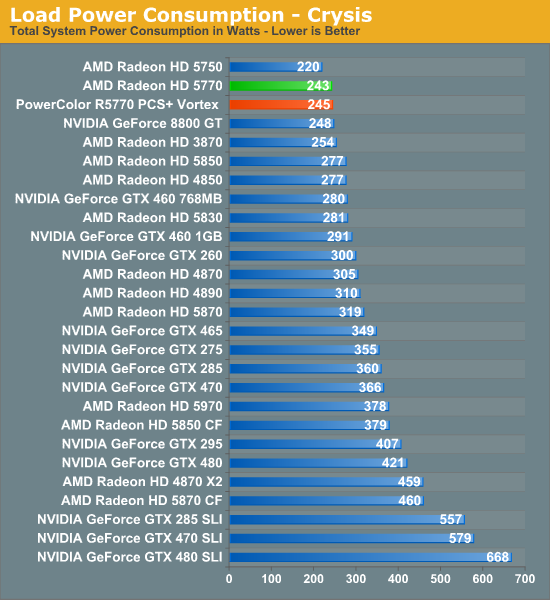
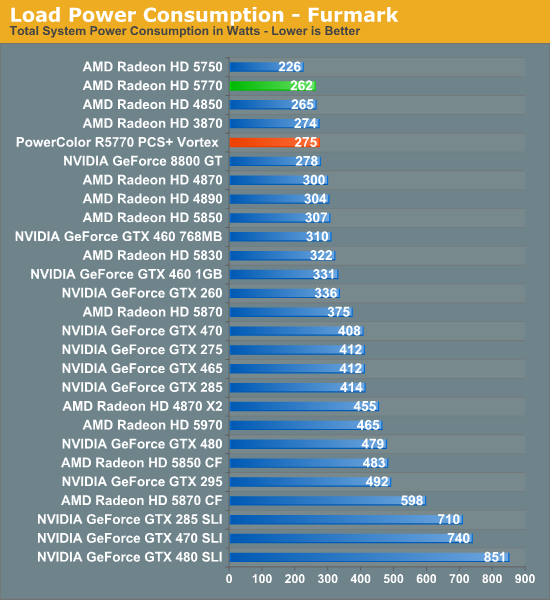
At idle, power consumption is unchanged from our reference 5770. Under load the Vortex ends up drawing slightly more power, which is to be expected due to the card’s slight overclock. Under Crysis this amounts to 2W more power draw, while FurMark sees a much more noticeable rise of 13W. All things considered we’re surprised to see that the power draw of the Vortex differ from the 5770 by so little – usually a shorter card has to give up some power efficiency in order to make the shorter length possible, but this is not the case for the Vortex.
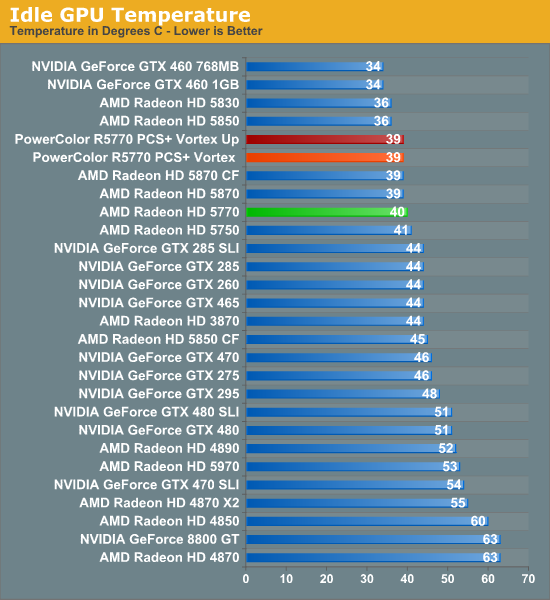
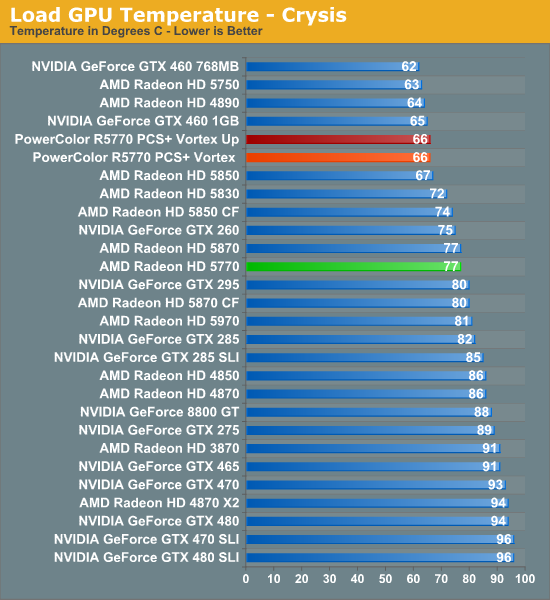
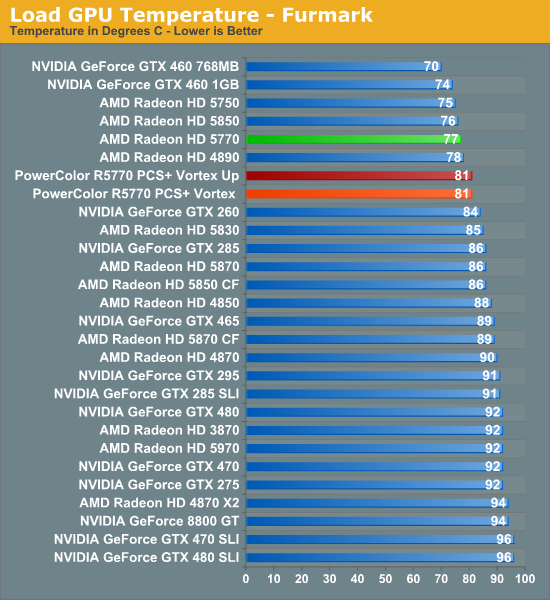
Moving on to temperatures, we have two different stories to look at. For idle temperatures the Vortex ends up being a mere 1C cooler than our reference 5770, an unsurprising outcome since idle temperatures vary little for any given GPU once you move to an appropriately large cooler.
Meanwhile the load temperatures are much more interesting – under Crysis our Vortex is an amazing 11C cooler than our reference 5770, while under FurMark the Vortex is 4C hotter. This is a much bigger discrepancy between Crysis and FurMark than what we see with our reference 5770, and after some digging the reason appears to be the fan profile in use. The Vortex has a more aggressive fan profile that results in it ramping up the fan sooner than the reference 5770 leading to the cooler Crysis temperatures, while under a very high load like Furmark the difference in how the two fans ramp up become much less pronounced. This is why the Vortex can be cooler under Crysis while running warmer under FurMark. Disregarding fan profiles, the Vortex cooler would appear to be ever so slightly less efficient than the reference cooler, which may be a benefit of the reference 5770’s embedded-fan design.
For our look at temperatures, the configuration of the Vortex’s fan had no impact on the temperature the card settled at. Retracted or extended resulted in the same temperatures, and indeed the same fan speed.
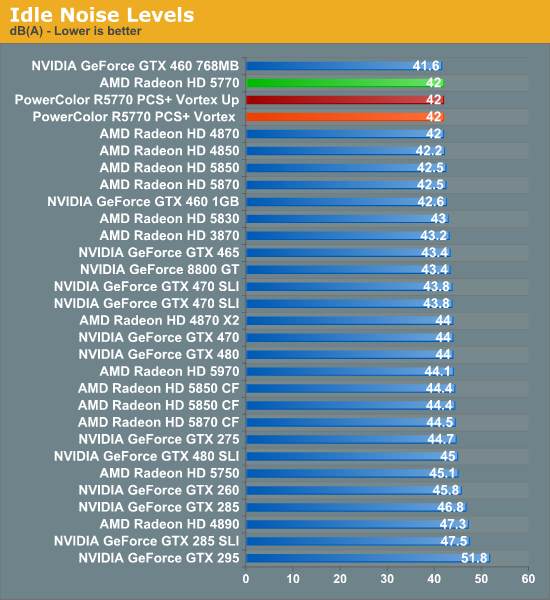
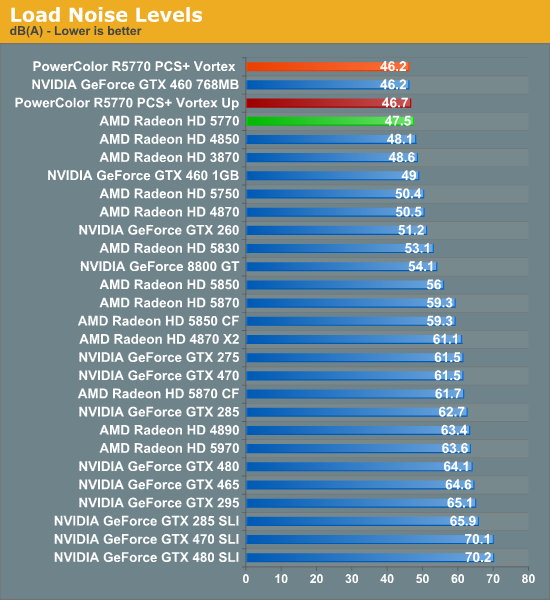
Last but not least we have noise. At idle our noise results are in-line with the reference 5770 and our other quieter cards, with all of those cards running in to the noise floor of testing environment. Under load we do find a difference between the Vortex and the reference 5770, however it’s only the slightest difference. The Vortex ends up being around 1dB(A) quieter than the reference 5770, which is something that we can measure but not something we could realistically perceive.
As for testing the Vortex’s fan, extending it had a slightly negative impact on the amount of noise generated under load. The card was at its quietest when the fan was retracted, generating 46.2dB(A) of noise, while extending it made the card 0.5dB(A) louder. It’s an academic difference at best, but one showcasing how the heatsink and the body of the card serve to muffle the noise from the fan by a slight degree.
Ultimately we have two things to take away from these results. The first is that when it comes to temperature and noise, the Vortex’s design simply doesn’t produce remarkably different results from the reference 5770. The Crysis results are very impressive, but this has more to do with the ramping profile of the card’s BIOS than it does the hardware. Under similar circumstances the Vortex’s cooler is slightly less efficient and slightly quieter than the reference cooler, which isn’t a bad tradeoff given the otherwise outstanding Crysis results.
The second thing we can take away is that the Vortex’s adjustable fan is little more than a gimmick. The only thing raising the fan accomplished is to make the card ever so slightly louder, but it didn’t do anything for cooling. We’ll grant PowerColor high scores here for effort, but it’s a very good thing for PowerColor that the adjustable fan doesn’t appear to have any negative impact on the card when it’s retracted, as this means the fan is merely an intellectual curiosity rather than a more serious design flaw.
All-told there is one good thing to come from the fan however: it’s easily removable. A removable fan makes it easier to clean the card without having to remove the heatsink or the shroud, the latter of which is held down by 4 very small screws.










26 Comments
View All Comments
JimmiG - Wednesday, August 25, 2010 - link
So the cooler manages to be almost as good as the stock cooler while being louder and potentially taking up more space. The card itself is about as overclockable as any other 5770 card and comes with a 6% factory overclock, while costing 10% more than other 5770 cards. No thanks.Ryan Smith - Wednesday, August 25, 2010 - link
Just to be clear, the cooler takes up no additional space unless you extend the fan. When it's lowered it's no wider than any other double-slot card, and since it's shorter overall it's smaller than the reference 5770.GatoRat - Wednesday, August 25, 2010 - link
This makes me want to buy a NVidia GTX 460! Runs cooler and faster and uses less power! The 768MB version sells for only $30 more.Goty - Wednesday, August 25, 2010 - link
Yeah, a whole 2-3 watts less at idle. Whoopee?Taft12 - Thursday, August 26, 2010 - link
... along with 40W more power at load and not $30 more, but $50 more.The GTX460 is a great product but can we please keep the fanboy exaggerations down?
JarredWalton - Wednesday, August 25, 2010 - link
I am not interested in 3-slot GPUs. What I'd actually like to see is a review of the single-slot 5770 by XFX. Mostly, what happens to noise and temperatures on that card. But then, I have a rather odd BTX motherboard/system that won't let me use more than a single-slot GPU. :-)ggathagan - Wednesday, August 25, 2010 - link
Jarred,As an SB86i owner, I agree, but until Anand gets you one to test:
http://www.hardwarecanucks.com/forum/hardware-canu...
Canuck's biggest beef: XFX gave up the HDMI connection for a 2nd DVI connection.
You gotta' talk to your boss about what's important.... :)
spac18 - Wednesday, August 25, 2010 - link
Hi everybody. I signed up to anandtech forums couple of weeks ago and activatrd my account. I can log into my account but when I try to post, it says that I dont have enough previleges or permisions to post. Whats going on? Sorry for being off topic, but this is the only way I can get help.LordanSS - Wednesday, August 25, 2010 - link
I was wondering if it'd be too much trouble, or impossible, to add more graphics cards to the GPU Bench... namely the mainstream cards? At least from this generation (5430->5475, 5570, and the nVidia equivalents, that jazz).Would be nice to have a couple from the old generation too (4650/4670, 4770, etc). Those cards are still widely available here in Brazil (and I suspect in the US too), so having a direct comparison tool like Bench, to see how much could be gained from an upgrade, or new build, would be really nice. =)
Keep up the good work! =)
vol7ron - Wednesday, August 25, 2010 - link
It's true, this site is not the best GPU review site. http://www.gpureview.com/ is okay.The articles are quality, but GPU review is not like CPU review, there are so many cards out there. Mobos and GPUs just require fulltime staff and lots of capital to test.